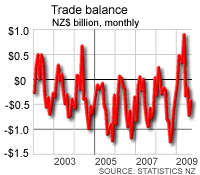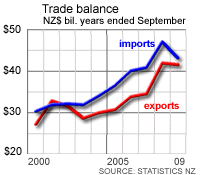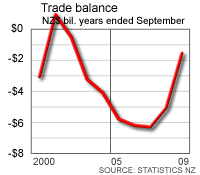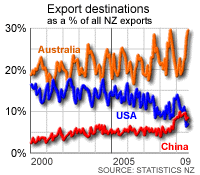 New Zealand exports to China were more than exports to the United States in July, the first month in which this has been the case, figures released by Statistics New Zealand (Stats NZ) show. (Update 3 with new head.) The rise in the level of New Zealand exports to China over the last year has caught the attention of economists as its fast growing economy snaps up New Zealand dairy, wood and now oil exports, while NZ exports of these items to other trading partners weakens. New Zealand recorded a merchandise trade deficit of NZ$163 million in July, compared to a deficit of NZ$797 million in July 2008. The improvement was due to a 20.9% fall in imports, compared to a 7.3% fall in exports over the year, Stats NZ said.
New Zealand exports to China were more than exports to the United States in July, the first month in which this has been the case, figures released by Statistics New Zealand (Stats NZ) show. (Update 3 with new head.) The rise in the level of New Zealand exports to China over the last year has caught the attention of economists as its fast growing economy snaps up New Zealand dairy, wood and now oil exports, while NZ exports of these items to other trading partners weakens. New Zealand recorded a merchandise trade deficit of NZ$163 million in July, compared to a deficit of NZ$797 million in July 2008. The improvement was due to a 20.9% fall in imports, compared to a 7.3% fall in exports over the year, Stats NZ said.
The July deficit was 5.1% of exports, compared to 23% of exports in July 2008. The deficit was similar to the forecast deficit of NZ$150 million from ASB and ANZ National, and better than the forecast deficits of NZ$480 million from Westpac and NZ$635 million by BNZ. The monthly deficit compared to a revised deficit of NZ$332 million in June (revised from NZ$417 million), which was blown out by a one-off import of large aircraft. The export value of New Zealand's largest export category, milk powder, butter and cheese exports, was down 2% in July from a year ago, despite export quantities being 54.2% higher than in July 2008.  New Zealand's annual trade deficit in the year to July was NZ$2.5 billion, from a deficit of just over NZ$3 billion in June and a deficit of NZ$4.5 billion in July 2008. Imports in the year to July 2009 fell 0.1% from the year to July 2008, the first annual fall for a July year since 2002. Exports in the year to July 2009 were up 4.8% from the year to July 2008. The value of merchandise imports was NZ$3.18 billion in the month of July, while the value of imports was NZ$3.43 billion. "After rising steadily from mid 2007, the trend for total merchandise exports has been declining and is down 7.4 percent since its peak in October 2008," Stats NZ said. "The strength in the export trend up until October 2008 was mainly a result of strong dairy prices and a substantial increase in crude oil exports." "Crude oil showed the largest decrease in July 2009, down $119 million (37.8 percent). This fall was almost entirely due to lower prices, with quantities similar to July 2008," Stats NZ said. "Meat and edible offal was the next largest fall, down $50 million (11.5 percent) as a result of lower quantities overall. This is the second consecutive monthly fall (compared with the same month of the previous year) and follows 14 consecutive monthly rises. The fall in July 2009 was led by frozen beef cuts and venison," it said. "Iron and steel and articles (down $35 million or 34.4 percent) and aluminium and aluminium articles (down $28 million or 27.3 percent) were the next largest falls." "Milk powder, butter and cheese fell $12 million (2.0 percent) compared with July 2008, despite quantities being 54.2 percent higher." "The largest increase for exports was preparations of cereals, flour and starch, up $20 million (35.7 percent) including a $10 million (120 percent) increase in dairy-based infant formula. Wine was the next largest increase up $19 million (28.8 percent) led by still white wine."
New Zealand's annual trade deficit in the year to July was NZ$2.5 billion, from a deficit of just over NZ$3 billion in June and a deficit of NZ$4.5 billion in July 2008. Imports in the year to July 2009 fell 0.1% from the year to July 2008, the first annual fall for a July year since 2002. Exports in the year to July 2009 were up 4.8% from the year to July 2008. The value of merchandise imports was NZ$3.18 billion in the month of July, while the value of imports was NZ$3.43 billion. "After rising steadily from mid 2007, the trend for total merchandise exports has been declining and is down 7.4 percent since its peak in October 2008," Stats NZ said. "The strength in the export trend up until October 2008 was mainly a result of strong dairy prices and a substantial increase in crude oil exports." "Crude oil showed the largest decrease in July 2009, down $119 million (37.8 percent). This fall was almost entirely due to lower prices, with quantities similar to July 2008," Stats NZ said. "Meat and edible offal was the next largest fall, down $50 million (11.5 percent) as a result of lower quantities overall. This is the second consecutive monthly fall (compared with the same month of the previous year) and follows 14 consecutive monthly rises. The fall in July 2009 was led by frozen beef cuts and venison," it said. "Iron and steel and articles (down $35 million or 34.4 percent) and aluminium and aluminium articles (down $28 million or 27.3 percent) were the next largest falls." "Milk powder, butter and cheese fell $12 million (2.0 percent) compared with July 2008, despite quantities being 54.2 percent higher." "The largest increase for exports was preparations of cereals, flour and starch, up $20 million (35.7 percent) including a $10 million (120 percent) increase in dairy-based infant formula. Wine was the next largest increase up $19 million (28.8 percent) led by still white wine."  The 20.9% fall in import values between July 2008 and July 2009 was the second largest monthly fall in percentage terms since February 1993, Stats NZ said. The largest was 21.8% in May 2009. "The trend for the value of merchandise imports has been decreasing since August 2008, down 22.5 percent since then, although the rate of decline appears to be easing. However, initial trend estimates may be revised and should be used with caution until more data points are available," Stats NZ said. "All of the main broad economic categories were down in July 2009 compared with July 2008, with the intermediate goods category recording the largest decrease, down $544 million (25.5 percent). This fall was led by decreases in automotive diesel and crude oil. Capital goods were down $132 million (18.6 percent) led by machinery and plant equipment. Passenger motor cars were down $124 million (43.3 percent). Consumption goods decreased $73 million (7.5 percent) over the same period." Proportion of exports to China rising as exports to US, Japan slow
The 20.9% fall in import values between July 2008 and July 2009 was the second largest monthly fall in percentage terms since February 1993, Stats NZ said. The largest was 21.8% in May 2009. "The trend for the value of merchandise imports has been decreasing since August 2008, down 22.5 percent since then, although the rate of decline appears to be easing. However, initial trend estimates may be revised and should be used with caution until more data points are available," Stats NZ said. "All of the main broad economic categories were down in July 2009 compared with July 2008, with the intermediate goods category recording the largest decrease, down $544 million (25.5 percent). This fall was led by decreases in automotive diesel and crude oil. Capital goods were down $132 million (18.6 percent) led by machinery and plant equipment. Passenger motor cars were down $124 million (43.3 percent). Consumption goods decreased $73 million (7.5 percent) over the same period." Proportion of exports to China rising as exports to US, Japan slow  ANZ National economists earlier in the week said to keep an eye on the level of New Zealand exports to China. They said that New Zealand's export performance over the last 12 months had been commendable given the weakness in its trading partners. "NZ has thankfully avoided the large falls in exports experienced by a number of Asian nations," they said. "One of the reasons for this has been the still solid demand for NZ dairy and log exports from China." "In fact, in June, NZ exports were down 11 percent on a year ago, while exports to China were up a whopping 50 percent. After taking close to 5 percent of NZ's merchandise exports in June 2008, China now takes closer to 8 percent. Part of this can be put down to stock-building. But we also think (hope) that it is showing flexibility on the part of NZ exporters in targeting the relative growth regions of the globe." China took the second largest value of NZ exports in July, behind Australia, taking over second place from the USA. In July, exports to Australia were down 16% from a year ago to NZ$731 million, while exports to the USA were down 29% from a year ago to NZ$297 million. Exports to China were up 52% to NZ$302 million. The falls in exports to Australia and the US were mainly due to falls in crude oil exports to the two destinations, Stats NZ said. Crude oil exports to Australia were down NZ$113 million and to the United States down NZ$102 million, with the US importing a single shipment of crude oil in July 2008 and nothing since. The major contributors to the increase in exports to China were crude oil exports, (which commenced in July 2009) at NZ$36 million; whole milk powder, up NZ$32 million; and pinus radiata logs, up NZ$29 million, Stats NZ said. In July, the proportion of NZ exports that were to China rose to 9.5% of total exports during the month, from 9.4% in June and 5.8% in July 2008 (see chart). The rise in the proportion of exports to China has been accompanied by a fall in the proportion of NZ exports that go to the USA, which fell to 9.3% in July from 12% a year ago, and Japan. In June, China overtook Japan for third place in the value of yearly NZ exports to the two destinations. Monthly exports to China have now totaled more than exports to Japan since December 2008. Current account deficit to narrow ASB economist Nick Tuffley said the narrowing of the annual trade gap meant that the current account deficit should keep narrowing in the short term.
ANZ National economists earlier in the week said to keep an eye on the level of New Zealand exports to China. They said that New Zealand's export performance over the last 12 months had been commendable given the weakness in its trading partners. "NZ has thankfully avoided the large falls in exports experienced by a number of Asian nations," they said. "One of the reasons for this has been the still solid demand for NZ dairy and log exports from China." "In fact, in June, NZ exports were down 11 percent on a year ago, while exports to China were up a whopping 50 percent. After taking close to 5 percent of NZ's merchandise exports in June 2008, China now takes closer to 8 percent. Part of this can be put down to stock-building. But we also think (hope) that it is showing flexibility on the part of NZ exporters in targeting the relative growth regions of the globe." China took the second largest value of NZ exports in July, behind Australia, taking over second place from the USA. In July, exports to Australia were down 16% from a year ago to NZ$731 million, while exports to the USA were down 29% from a year ago to NZ$297 million. Exports to China were up 52% to NZ$302 million. The falls in exports to Australia and the US were mainly due to falls in crude oil exports to the two destinations, Stats NZ said. Crude oil exports to Australia were down NZ$113 million and to the United States down NZ$102 million, with the US importing a single shipment of crude oil in July 2008 and nothing since. The major contributors to the increase in exports to China were crude oil exports, (which commenced in July 2009) at NZ$36 million; whole milk powder, up NZ$32 million; and pinus radiata logs, up NZ$29 million, Stats NZ said. In July, the proportion of NZ exports that were to China rose to 9.5% of total exports during the month, from 9.4% in June and 5.8% in July 2008 (see chart). The rise in the proportion of exports to China has been accompanied by a fall in the proportion of NZ exports that go to the USA, which fell to 9.3% in July from 12% a year ago, and Japan. In June, China overtook Japan for third place in the value of yearly NZ exports to the two destinations. Monthly exports to China have now totaled more than exports to Japan since December 2008. Current account deficit to narrow ASB economist Nick Tuffley said the narrowing of the annual trade gap meant that the current account deficit should keep narrowing in the short term.
The annual trade deficit, at $2.5bn, is the lowest it has been since mid-2003. That reinforces that the current account deficit will continue to narrow in the short term. However, the pace of closure is likely to slow soon. Exports have been held up by a recovery in dairy volumes from drought-affected levels, and NZ is moving out of the peak pastoral export season. Meanwhile, the noticeable decline in imports will taper off as domestic demand stabilises. Nevertheless, we expect that, on an ongoing basis, the current account deficit will continue to narrow in coming years through a combination of moderate import demand and an eventual recovery in export earnings once the global economy is on a surer footing.

We welcome your comments below. If you are not already registered, please register to comment.
Remember we welcome robust, respectful and insightful debate. We don't welcome abusive or defamatory comments and will de-register those repeatedly making such comments. Our current comment policy is here.